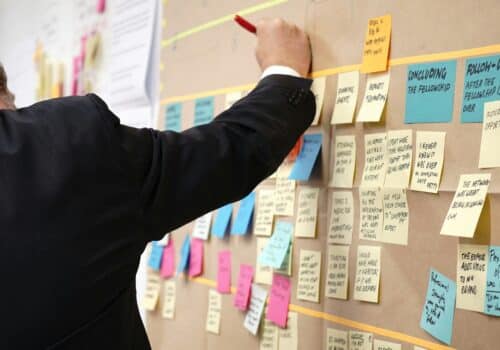July Connections video: This is the first step to business transformation
In last month’s video, I talked about why the hot topic of digital transformation doesn’t get manufacturing companies where they need to go. We need to broaden the conversation to encompass business transformation — because technology is just a piece of the success puzzle.
This month I’m digging in deeper.
In this video, you’ll hear about the first part of the four-step process of business transformation.
As they say, once you see the whole picture, “you can’t unsee it.” Looking at business transformation holistically, you see how people, processes and technology are connected. ERP is a foundational element, but it doesn’t work independently of the whole of business growth.
I think you’ll find this video powerful.
Hi, Erin Koss, CEO at Syte Consulting Group. Recently. I wrote an article on business transformation and I wrote this article because it seemed like digital transformation and the ideas behind it were showing up everywhere. I just felt like they were missing the whole picture. This idea that we want to text, we want to automate, we want to use technology to our advantage just seems to come up short for our clients who are family owned manufacturing companies, companies looking at the long term and looking at making more holistic long term changes when they invest their time and money.
Business transformation is something at Syte Consulting Group we take really seriously. We think about it like a road trip, if you will. It’s a crawl, walk, run kind of strategy. It kind of reminds me of a road trip. So this idea where you might start out kind of on a bumpy road, not knowing where you’re going to go or how you’re going to get there. As you get a good map in front of you and the right people in the right seats next to you, you can get where you’re trying to go in stages.
Eventually, you go from being on a gravel road, a bumpy road to being maybe on a four-lane highway where it’s nice, smooth pavement. The signs just have so much clarity. When we talk about business transformation, this is what we think of and for us, it tends to be four pieces that get our clients where they’re trying to go. The first of those is measuring where you’re at or doing his evaluation of where are we at, how ready are we to take on a big change initiative?
The next is doing a business assessment. Where are the processes at in the business? How involved are they? Were the issues with them? And what about the people that are responsible for executing those processes? So we do a business assessment of both the process and the people that are really critical to driving those processes next. It’s an idea of what solutions are going to be the best fit in evaluating those solutions within your organization, solutions being some of that is technology.
Some of that is ERP solutions. Some of it might be a best of breed solution. It might also be a training solution. It could be a lot of different things. But again, what are the requirements for our client’s business and what are the solutions that need to be built around those requirements? Lastly, there is implementation. You’ve decided you’ve figured out and measuring where you know the gaps and issues are. Where are you at today? You’ve assessed the business for the critical processes and the people, and then you’ve evaluated the solutions and what you need to succeed.
Now it’s about implementing those solutions for success. Foundational to that is the work that we’ve done for many, many years is implementing ERP solutions, of course, which are foundational, but they’re just the start. There’s so many other pieces that are involved, including people, process and technology and the thing I want to highlight today is maybe the first of a series of conversations we’re going to have via these connection videos and also some additional articles which are going to focus on why are these different steps in the journey matter?
You’re on a road trip. Why does taking that first step of measurement and evaluation? Why is that so important and how does it add value? The thing that we’ve seen in the rearview mirror, so to speak, is when companies take on, say, evaluating solutions before they consider where they’re at and how ready they are to do so, or worse yet, implement solutions before they have any consideration of those things as well. They can get out over their skis, both in time cost and just plain burn out and impact on their people in a way they never intend.
One of the things, a business evaluation or measuring your readiness, as we call it is technically we call it a transformation readiness evaluation. It’s really an evaluation meant to measure how capable are your capabilities and capacities relative to taking on some really important business transformation initiatives. What we find is there’s there’s many areas of gap that that can come up, but the most critical areas are really relative to people’s capabilities and capacities. A lot of times these projects that are so foundational to transforming a business ERP being one example, what we find is companies don’t take on these projects very often, if ever.
And so there are people are just plain don’t have the capabilities to do do what’s asked. They aren’t project managers, they aren’t business analysts or technical analysts. And so they often just don’t flat out don’t have the capabilities. The other piece is that they have the they have the subject matter experts in the organization that are required for these projects. They have great people, but these people are doing a day job and they can’t imagine pulling those folks out of their day job and asking them to.
Participate on a really, you know, a really critical project for 50 percent of their time. Yes. In fact, most special projects that we’re talking about that will transform your business are going to pull and require anywhere from 25 to 75 percent. We like to say around 50 percent of your subject matter experts time. So when you go to build a core team of people to execute important initiatives like this and they have their day job, and so you need to think about how can you do that?
How are you going to plan for taking these folks out of the organization part time when they’re so busy as it is? And so one of the things we find is people are clients really underestimate the effort, the length of time it’s going to take to and the necessary effort that’s going to be required of these folks. And so what happens is and we’ve seen this time and time and again, as these projects will take twice as long as they need to cost twice as much as they need to. Worse yet, burn out your people in ways that you never expected. What we recommend is take 30 days.
The evaluation and assessment upfront of your own readiness or readiness for business transformation honestly can be done in less than 30 days. And for us, you know, it’s a matter of probably 10 hours or less in terms of consulting time on our part to help support the effort. We ask our clients we have this kind of neat tool that we provide to help our clients measure exactly where they’re at from a readiness perspective.
We walk through that in a short amount of time with you and get an assessment of where the gaps and issues are specifically. Again, usually related to capabilities and capacity, but we get real specific about where those are and then can help you troubleshoot, make recommendations for how do you solve this issue? Is it bringing temporary resources in or experts in from the outside to do certain roles, specific tasks that maybe you don’t need if you’re not running a project, things like a project manager, business analyst or technical analyst, roles that maybe you don’t need long term and roles that also could really help level up the people in your organization that are going to be there long term to support these these systems and solutions that you put in place.
Often times, that’s a solve. There’s also temporary backfilling of some of those resources or just in general temporary help in an administrative way that can support as well. But there’s lots of ways to skin that capability and capacity gaps that show up so often. We like to see our clients spend the 30 days to just do that evaluation and get good feedback and get to the place where they can make good decisions about how they’re going to provide for these projects and be really prepared before diving into the second step in the process, which is business assessment.
The next time we get together and we talk for a few minutes to continue the conversation about business transformation, focused on business assessment, what it’s about, how long it takes, who might need to be involved and why it’s important and what happens, what can what maybe what the impacts are when when you don’t do it. I hope you’ll join us as we take on a series of conversations about business transformation, the journey, if you will, on the road from the bumpy gravel road to the smooth, open highway that we find when we go through this process in a methodical and flexible way.
But follow I hope you’ll join us as we go down this journey together. Let’s talk about readiness evaluation today. We’ll talk about business assessment next. We’ll follow that with evaluation and then finally, implementation. By the time we were done, I think you’ll have a fairly good picture of the four steps needed to really execute a business transformation initiative within your organization. As we go along the way, if you have questions, comments, concerns, feedback, even like we’d love to hear from you and if it would serve you to have a conversation more broadly or one on one, feel free to reach out any time.
We’ll look forward to chatting with you some more. Take care.
ERP Readiness Self-Assessment
Is your organization ready for a new or upgraded ERP solution? Find out with this complimentary self-assessment.
Doing Business Better
You strive for excellence, believe in your people, and want to do things right the first time. And you know that you need help to get to the heart of your business challenges and make the best choices for the future of your privately held manufacturing and distribution company. That’s where we come in.
We help you focus and find exactly the right path to accelerated growth and sustainable success — from your people to your processes to your ERP software.



